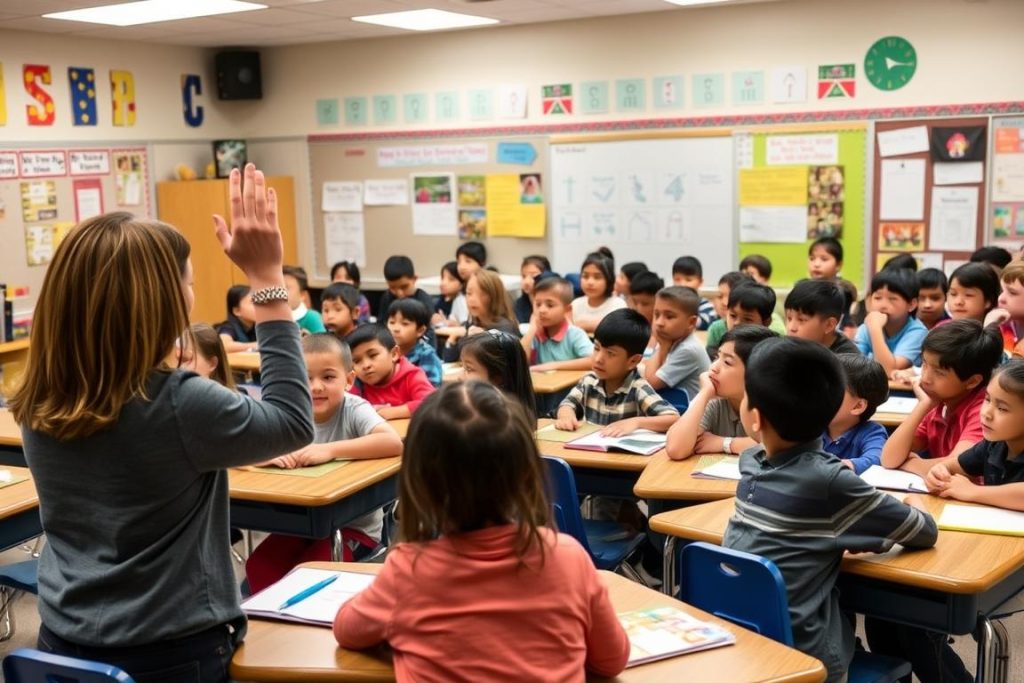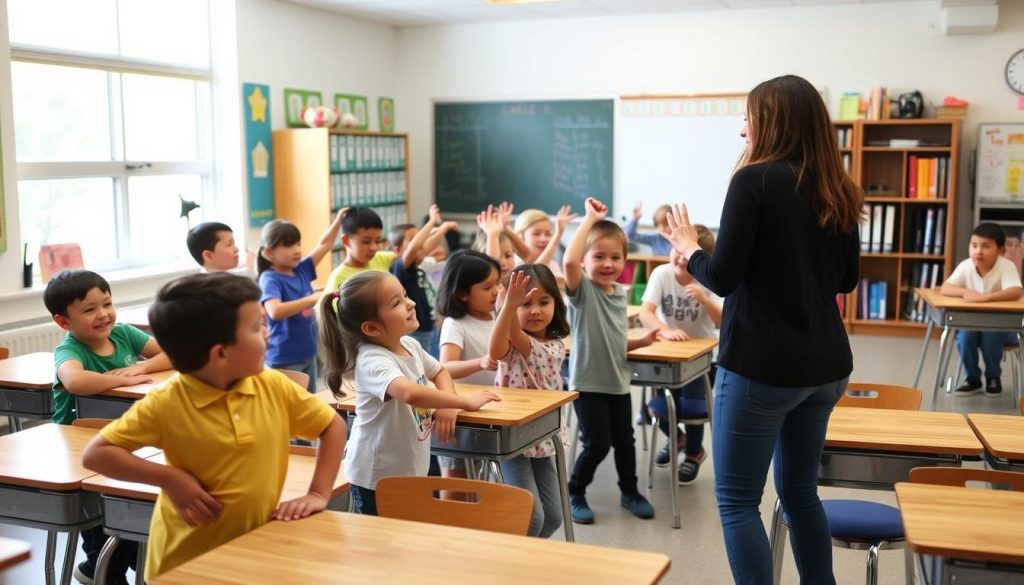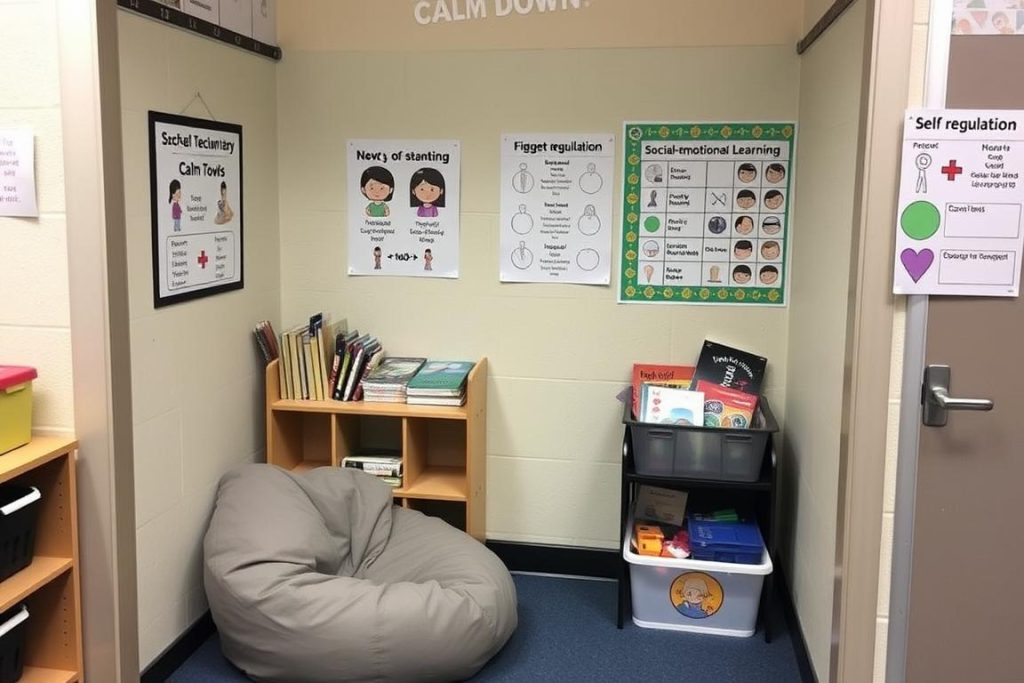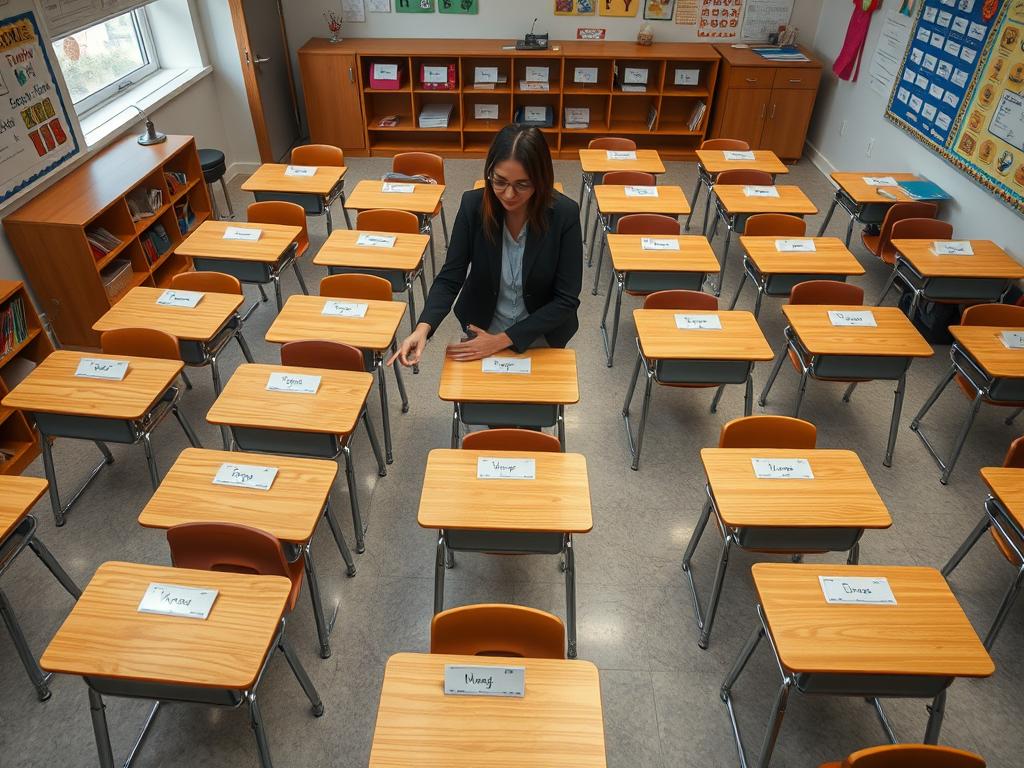In this article, I’ll walk you through strategies that have been tested and refined by teachers across the country. These aren’t just theoretical concepts—they’re practical approaches you can implement tomorrow morning. Whether you’re a first-year teacher still finding your footing or a veteran educator looking for fresh perspectives on classroom management, these ideas will help you reclaim your classroom and create the positive learning environment your students deserve.
Idea 1: Strategic Seating Arrangements for a Rowdy Classroom
One of the most powerful yet underutilized tools for managing a rowdy classroom is your seating chart. The physical arrangement of your classroom can either fuel or diminish disruptive behavior. When I first started teaching, I allowed students to sit wherever they wanted—a rookie mistake that quickly turned my classroom into a daily social hour.
Consider implementing a seating arrangement that separates students who tend to feed off each other’s energy. This doesn’t mean you need to isolate friends completely, but strategic placement can work wonders. For example, placing a naturally talkative student next to a more focused peer can help model appropriate classroom behavior.
Different seating arrangements serve different purposes. For collaborative work, small groups of 3-4 students can be effective, while a U-shape arrangement allows you to maintain eye contact with everyone during discussions. For independent work, traditional rows might be your best bet to minimize distractions.
Don’t be afraid to experiment with flexible seating options if your resources allow. Some students in a rowdy classroom actually focus better when they have alternative seating like standing desks, wobble stools, or floor cushions. These options can help channel excess energy in a productive way.
Remember that your seating arrangement shouldn’t be set in stone. Be prepared to make adjustments based on your observations. What works for one class might not work for another, and what works in September might need tweaking by November. Credits for Teachers offers additional resources on classroom arrangement strategies that can help you maximize your space for optimal learning.
Idea 2: Establish Clear Expectations in Your Rowdy Classroom
A rowdy classroom often stems from unclear expectations. When students don’t know exactly what behavior is expected of them, they default to what’s most natural—which for many kids means talking, moving, and socializing. Setting clear, consistent expectations is foundational to creating a calm learning environment.
Start by developing 3-5 core classroom rules that are specific, positively phrased, and easy to remember. Instead of “No talking,” try “Use a level 1 voice during independent work time.” Rather than “Don’t run,” say “Move safely using walking feet.” These positive phrasings help students understand what they should do, not just what they shouldn’t.
Once you’ve established your rules, teach them explicitly. Don’t assume students know what “respect” looks like in practice. Role-play scenarios, demonstrate examples and non-examples, and discuss why these expectations matter. This investment of time upfront will save you countless hours of redirection later.
Visual reminders are particularly effective for maintaining expectations in a rowdy classroom. Create posters, desk tags, or digital displays that reinforce your rules. For younger students, pictures alongside text can help those still developing reading skills.
Consistency is key. If you enforce a rule one day but ignore the same behavior the next, students will quickly learn that your expectations are negotiable. This doesn’t mean you can’t be flexible when circumstances warrant it, but your core expectations should remain steady.
When expectations are violated (and they will be), respond calmly and matter-of-factly. Remind students of the expectation, redirect them to the appropriate behavior, and move on. Dwelling on misbehavior often gives it more power and disrupts the learning environment further.
Idea 3: Use Attention Signals to Refocus a Rowdy Classroom

Consistent attention signals help quickly refocus student attention
When a rowdy classroom is in full swing, trying to talk over the noise only adds to the chaos and strains your voice. Attention signals provide a non-verbal way to quickly regain your students’ focus without raising your voice or becoming frustrated.
Choose a signal that engages multiple senses. Visual signals might include raising your hand, flicking the lights, or using a specific gesture. Auditory signals could be a chime, bell, or clapping pattern. The most effective signals combine both—for example, raising your hand while saying “Give me five” or ringing a bell while moving to a specific spot in the room.
Whatever signal you choose, teach it explicitly and practice it regularly. When first introducing your attention signal, have students practice responding to it multiple times in a row. Make it fun—”Let’s see how quickly we can all get quiet and focused when I ring this bell!” This builds muscle memory and helps students respond automatically when they see or hear your signal.
An effective technique I’ve used in particularly rowdy classroom situations is the “cascade effect.” When you give your signal, acknowledge the first students who respond with a quiet “Thank you for being ready” or a simple nod. This positive reinforcement often creates a ripple effect as other students notice and follow suit.
For older students who might find traditional signals “babyish,” involve them in creating a class signal that feels age-appropriate. This ownership increases buy-in and compliance. One middle school teacher I know uses a Star Wars theme—when she says “The Force,” students respond “is with us” and immediately quiet down.
Remember that your response after giving the signal matters too. Wait until you have everyone’s attention before speaking. If you start talking while some students are still chatting, you undermine your own system. Patience here pays dividends in the long run.
Take Your Classroom Management to the Next Level
Looking for more comprehensive strategies to manage classroom behavior? Our Effective Discipline CE Course provides research-backed approaches to creating a positive learning environment where students can thrive. From preventative techniques to intervention strategies, this resource gives you the tools you need to transform your classroom management approach.
Idea 4: Incorporate Movement Breaks in a Rowdy Classroom

Strategic movement breaks can help students release energy and refocus
Sometimes, the best way to calm a rowdy classroom isn’t to fight against students’ natural energy but to channel it productively. Our bodies aren’t designed to sit still for extended periods, especially children’s bodies. Incorporating regular, structured movement breaks can actually improve focus and reduce disruptive behavior.
Brain research supports this approach. Studies show that physical activity increases blood flow to the brain, improving cognitive function and attention. A 3-5 minute movement break can reset students’ focus for the next 20-30 minutes of learning. Far from “wasting time,” these breaks actually make your instructional time more effective.
Keep movement breaks brief, structured, and relevant when possible. For younger students, songs with movements like “Head, Shoulders, Knees and Toes” or simple yoga poses work well. For older students, quick stretching routines, standing discussions where students move to different parts of the room based on their opinions, or even a 60-second dance party can be effective.
Timing is crucial when implementing movement breaks in a rowdy classroom. Look for natural transition points between activities or subjects. Watch for signs that students are becoming restless—increased fidgeting, off-task conversations, or glazed expressions are good indicators that a movement break is needed.
Establish clear expectations for movement breaks just as you would for any other classroom activity. Students should understand exactly what the break will look like, how long it will last, and how they should behave during and after the break. Use a timer or specific music duration to signal the beginning and end.
For students who struggle with self-regulation, provide additional structure during movement breaks. Assign specific spots on the floor, give them a particular role, or partner them with a peer who models appropriate behavior. This support helps them benefit from the break without becoming more dysregulated.
Resources like GoNoodle offer ready-made movement break videos that require minimal prep and can be filtered by grade level, activity type, and duration. These tools make it easy to incorporate movement even when you’re short on planning time.
Idea 5: Implement a Positive Reinforcement System for Your Rowdy Classroom
While clear expectations are essential, students also need motivation to meet those expectations, especially in a naturally rowdy classroom. Positive reinforcement—recognizing and rewarding desired behaviors—is one of the most powerful tools in a teacher’s arsenal.
The most effective reinforcement is specific and immediate. Rather than a generic “Good job,” try “I noticed how quickly you got started on your writing assignment. That shows real responsibility!” This specificity helps students understand exactly which behaviors earn recognition, making them more likely to repeat those behaviors.
Consider implementing both individual and group reinforcement systems. Individual systems might include behavior charts, token economies, or privilege cards. Group systems could be marble jars, class points, or team competitions. The combination addresses both personal responsibility and community building.
For younger students, tangible rewards like stickers, small prizes, or extra recess time can be highly motivating. As students mature, social reinforcers like public recognition, positive notes home, or special responsibilities often become more effective. Tailor your approach to your students’ developmental stage and interests.
Remember that the goal of any reinforcement system is to gradually fade external rewards as students internalize expectations. Start with frequent reinforcement, then gradually reduce the frequency while maintaining the positive feedback. This progression helps develop intrinsic motivation over time.
One particularly effective approach for a rowdy classroom is “catching students being good.” Make a conscious effort to notice and comment on positive behaviors, especially from students who typically struggle with behavior expectations. This shifts the classroom dynamic from reactive discipline to proactive reinforcement.
For more comprehensive strategies on positive reinforcement systems, Credits for Teachers offers resources specifically designed for educators looking to transform classroom behavior through positive approaches.
Idea 6: Create Calm-Down Spaces in Your Rowdy Classroom

A well-designed calm-down space gives students tools to self-regulate
Even with the best management strategies, there will be times when individual students in a rowdy classroom become overwhelmed, frustrated, or simply need a break. Creating designated calm-down spaces gives students a tool for self-regulation and prevents individual struggles from escalating into class-wide disruptions.
A effective calm-down space isn’t a punishment corner—it’s a support strategy. Position it as a resource that helps students manage their emotions, not as a consequence for misbehavior. Language matters here: “Would you like to use the calm corner to help you reset?” feels very different from “Go to the corner until you can behave.”
Stock your calm-down space with tools that support emotional regulation. These might include stress balls, breathing guides, emotion identification charts, journals, headphones, or sensory items like kinetic sand. Different students respond to different tools, so variety is helpful.
Teach students explicitly how and when to use the calm-down space. Role-play scenarios where it would be appropriate to take a break, demonstrate how to use the tools provided, and practice the process of returning to class activities. This preparation helps ensure the space is used effectively.
Establish clear guidelines for using the space. How many students can use it at once? How long can a student stay? What should they do when they’re ready to rejoin the class? Having these procedures in place prevents misuse and helps maintain the integrity of the space.
For older students who might resist a designated “calm corner” as too childish, consider alternative approaches like cool-down passes they can use to take a short break at their desk or just outside the classroom door. The key is providing the opportunity for self-regulation in an age-appropriate way.
Monitor the use of your calm-down space to identify patterns. If certain students are using it frequently, or if specific activities or times of day seem to trigger the need for breaks, this information can help you make proactive adjustments to your classroom environment or schedule.
Transforming Your Rowdy Classroom: Putting It All Together
Managing a rowdy classroom isn’t about implementing a single magic solution—it’s about creating a comprehensive approach that addresses the physical environment, clear expectations, engagement strategies, and emotional support. The six ideas we’ve explored work best when used in combination, creating layers of support that help all students succeed.
Remember that transformation doesn’t happen overnight. Be patient with yourself and your students as you implement these strategies. Start with one or two approaches that seem most relevant to your specific classroom challenges, then gradually add others as these become routine.
Pay attention to what works and what doesn’t in your unique context. Every classroom has its own personality, and strategies that work brilliantly in one setting might need adjustment in another. Your willingness to observe, reflect, and adapt is one of your most powerful tools in creating a positive learning environment.
Most importantly, maintain your connection with students throughout this process. Even the most challenging behaviors often stem from unmet needs—for attention, competence, belonging, or security. When students know you care about them as individuals, they’re much more likely to meet your expectations and contribute positively to the classroom community.
With consistent implementation of these strategies, your rowdy classroom can transform into a space where meaningful learning thrives. The journey requires patience and persistence, but the results—engaged students, productive learning time, and your own professional satisfaction—are well worth the effort.
Continue Your Professional Development
Ready to explore more strategies for effective classroom management? Visit Credits for Teachers for additional resources, professional development opportunities, and our comprehensive Effective Discipline Course. Transform your teaching practice and create the positive learning environment your students deserve.




